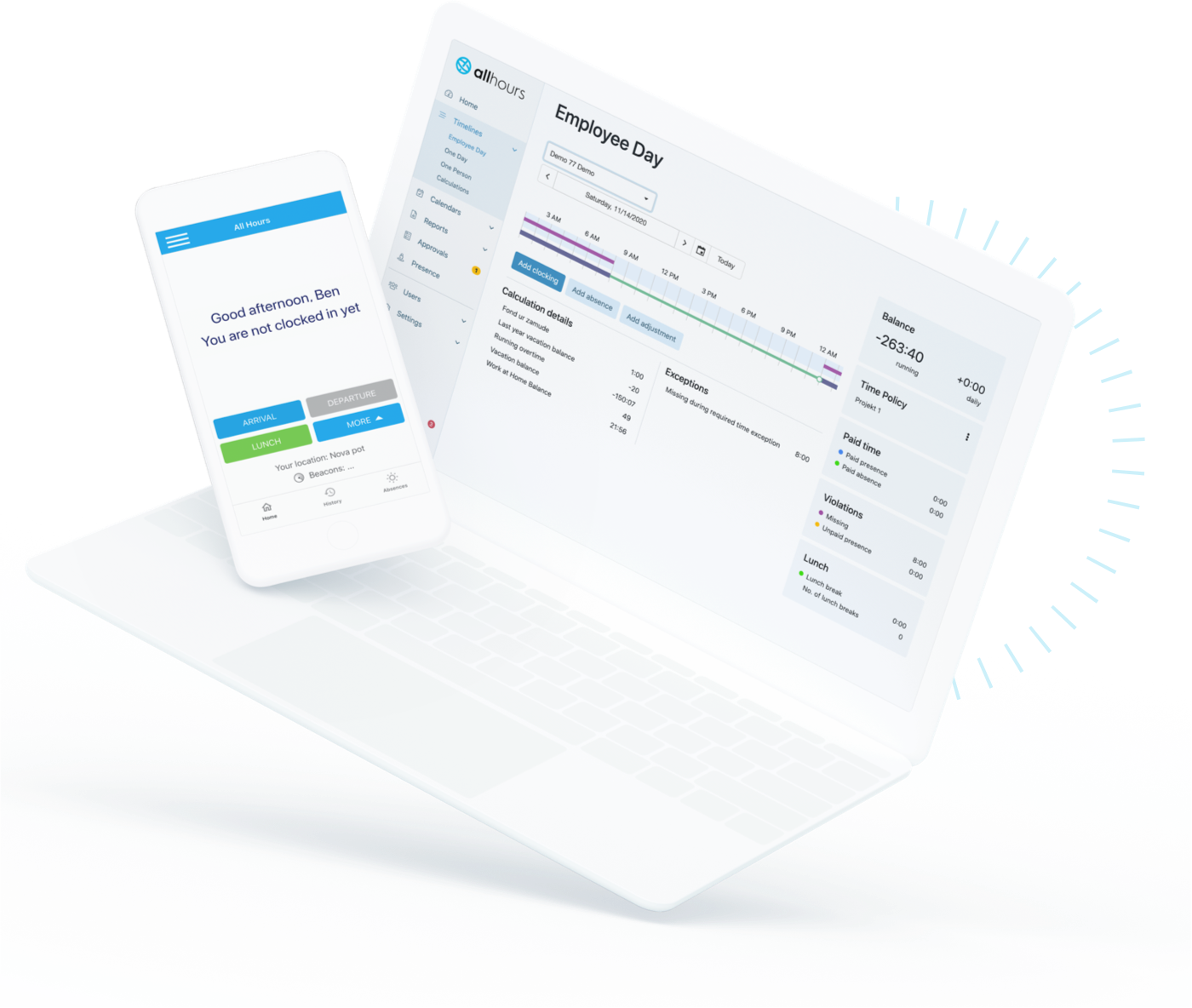The European working time directive – what you need to know


The European working time directive (EWTD, passed in November 2003) regulates labour and working time for employees.
At their core, these standards regulate minimum daily and weekly periods of rest, adequate breaks, night work, annual leave, and the maximum limit on weekly working hours.
Each European Union (EU) member state is obliged to make its own national laws and define the specifics, using the EWTD as general guidance. Some EU member states have even tougher legislation regarding some aspects of the directive and are more liberal on others.
In addition, the European Union's highest court ruled (in May 2019) that all employers must track the time and attendance of their employees.
The ruling overrides all other national laws of each EU member state, no matter what existed before. Following the ruling, the situation in EU is similar to US, where all businesses are required to track time in order to be FLSA compliant.
That means every employer in the EU must track time and attendance of their employees, meet the minimum standards defined in the EU directive, and of course be compliant with the national legislation that’s been implemented based on the directive.
If you are an employer, it serves you to be well aware of the European working time directive and its most important parts.
The main elements of the European working time directive (2003)
The main purpose of the European working time directive (ETWD) is to protect employees’ health and safety.
Too many working hours and insufficient rest time has been proven to lead to burnouts, depression, illness, and toxic stress.
In a way the directive also protects employers, since the long-term goal of every employer should be to have healthy, well-rested and consequently productive employees.
In addition, precise time and attendance tracking brings many other advantages for both parties: employees can easily assert their rights, while employers are able to track the actual time spent completing a task, which is the basis for calculating productivity or efficiency.
Now let’s look at the main elements of the European working time directive and its regulations, with an example of an implementation on the national level (in our case in Slovenia, since that is where our headquarters are located).
Working time and daily rest
According to the EWTD, employers have to ensure that employees do not work more than 48 hours, including overtime work, over a seven-day period, calculated as an average for a period of four months.
Every worker is entitled to 11 hours of uninterrupted rest daily, and 24 hours of uninterrupted rest after each seven-day period, which must be taken within a 14-day period.
However, as mentioned some local legislation is even tougher. For example, Slovenian legislation defines 12 hours of rest between two successive working days; an 11-hour rest is only possible if the working pattern is irregular.
Employees with an irregular working pattern are allowed to work 56 hours per week, but the average working hours in a6-month period (or 12 months, if defined so in the collective agreement, e. g. for tourism or hospitality) should not exceed 40 hours per week.
The employee may have a maximum of 8 overtime hours per week, 20 per month, and 180 per year.
Rest break
Where the working day is longer than six hours, every worker is entitled to a rest break, with the duration of that break defined in the legislation of each member state. In Slovenia, employees working full time are entitled to a 30-minute break calculated into their working time.
Furthermore, all employees working more than four hours per day are entitled to a proportional share of paid rest break. However, these rules are often not obeyed; in Slovenia, it has become common to work nine hours with a one-hour break. This violates Slovene legislation unless the additional hour counts as overtime.
Annual leave
Every worker is entitled to paid annual leave of at least four weeks.
The annual leave may not be replaced by an allowance, except where the employment relationship is terminated before the employee is able to take the leave.
Night work
A night worker is an employee working at night for at least three hours of their daily working time or working at night for at least one third of their full annual working time.
Night-time in the EU is the period between midnight and 5 a.m., in Slovenia between 11 p.m. and 6 a.m.; or in case of shift work between 10 p.m. and 7 a.m.
Normal hours of work for night workers should not exceed an average of eight hours in any 24-hour period. Night workers with demanding jobs are not allowed to work more than 8 hours in any 24-hour period.
In this case, Slovenian legislation is more liberal, since it defines that in a 4-month period the average night shift of a night worker should not exceed 8 hours per day, while the limitation of 8 hours in a 24-hour period is only set by positions with a greater danger of injuries or health problems. A night worker is entitled to longer annual leave, however, it is not defined how much longer it should be.
Read more:
- German implementation of the directive (in English)
- Spanish implementation of the directive (in Spanish)
The European working time directive is not obeyed to the point it should be
The European Commission pointed out that the Directive has been in place since 2003, but is often not obeyed or interpreted correctly; mostly because employers do not have an appropriate time and attendance system that would enable precise tracking of working time.
According to the Labour Inspectorate of the Republic of Slovenia, the majority of violations in Slovenia occur in civil engineering, hospitality, tourism, and retail.
The Inspectorate has brought the issue of the insufficient legislation to the Slovenian Government several times. Inspectors have also observed an increase in part-time employment, although most employees actually work for eight or more hours per day.
Working time violations are often the result of sick leave and understaffing.
Furthermore, inspectors report on employers in retail who tend to ask their employees to register their arrival when they actually start working, although they arrive earlier to get ready for work (e.g., to change their clothes etc.). This time is not being registered as working time.
Violations are also frequent in the case of irregular working time, where the maximum allowed number of working hours per week is 56.
As seen above, the work legislation is precise, but negligence in its execution may be harmful for employees as well as employers.
Due to the increased number of violations identified in all Member States, the Member States will be obliged to enforce systematic and very precise tracking of working time.
The new EU time and attendance requirements (2019)
As mentioned, insufficient legislation has allowed employers to avoid working time regulations, most frequently by simply not keeping track of hours, and the EU is determined to stop such behaviour.
A step in this direction occurred on May 14th 2019, when the European Court of Justice (ECJ) ruled that EU member states must require from all EU companies to set up a system allowing them to record the daily working time of their employees.
EU member states are obliged to make such systems mandatory in order to enforce legal limits on working hours and ensure labour laws are being complied with. The decision stemmed from a lawsuit in Spain against Deutsche Bank.
Under European legislation and the Charter on Fundamental Rights, every worker is entitled to work only a limited number of hours and to have daily and weekly rest periods.
Member states must ensure that workers actually benefit from these rights, by setting up “…an objective, reliable and accessible system enabling the duration of time worked each day by each worker to be measured…” said the ECJ in the statement.
“In the absence of a system enabling the duration of time worked each day by each worker to be measured, it is not possible to determine, objectively and reliably, either the number of hours worked and when that work was done, or the number of hours of overtime worked, which makes it excessively difficult, if not impossible in practice, for workers to ensure that their rights are complied with.”
The ECJ added that, due to the increased number of violations identified in all Member States, the Member States will be obliged to enforce systematic and very precise tracking of working time, while each country is free to define how to implement such a system.
Time and attendance in the flexible work environment
As we know, in modern business environments working hours are far from clearly defined.
The court ruling could have a great impact on this definition, however, they have not yet specified whether, for example, quickly replying to a work-related e-mail from home should be recorded as being part of working time as well. Details will still need to be discussed.
A German confederation of employers found the idea of returning to workers punching in and punching out on arrival and departure impractical given modern working practices, smartphone use, and the rising trend of working from home.
But impracticality alone shouldn’t stand in the way of properly applying legal working-time limits. Without such measures it is “excessively difficult, if not impossible in practice, for workers to ensure that their rights are complied with.”
Workers must be regarded as the weaker party in the employment relationship. It is necessary to prevent employers from being in a position to restrict their rights.
»The court puts a stop to flat-rate work, and rightly so,” commented Annelie Buntenbach, board member of the German Trade Union Confederation DGB. “Flexibility will not suffer, on the contrary: Instead of with a punch clock, working hours can today be documented with smartphones and apps, after all.”
She is absolutely correct. Just as working environments have transformed immensely, so has the recording of working hours, and the classic punch clock will definitely not make a great comeback because of this ruling.
But with smart online clocking app like All Hours, our time and attendance solution, there is absolutely no good reason for employers to avoid keeping records of working hours, vacation days, and breaks.
All Hours even allows employers to set different flexible, full-time, or part-time schedules for their employees, and of course with the mobile application remote employees can seamlessly enter their work hours from anywhere.






